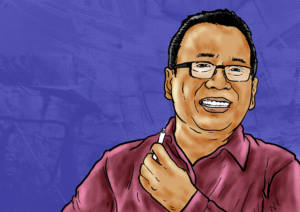Yamidi’s mobile phone rang as he received a notification from major cigarette company PT Gudang Garam to come to a meeting to discuss tobacco prices at the company’s warehouse. In the meeting held on Friday, August 7, the company set the price of dried tobacco at a range between Rp 15,000 to Rp 50,000 per kilogram, only half of last year’s price.
According to Yamidi, the cigarette company could not pay more because the quality of tobacco harvested this year was not good. Besides, the company also decreased the quantity of tobacco they purchased, due to the Covid-19 pandemic. Usually, in every harvesting season, Gudang Garam could buy 20 tons of tobacco from the farmers.
“We could not bargain anymore,” 48-year-old Yamidi told Jaring.id on a phone interview on Monday, October 19.
Gudang Garam, he added, is the only company that bought tobacco from Temanggung, Wonosobo, and Kendal during this pandemic. Other cigarette manufacturers, including PT Djarum, have yet to purchase the harvested tobacco from the farmers.
Jaring.id tried to confirm this to both PT Gudang Garam and PT Djarum. However, there has been no response from the two companies until this article was published.
In Magelang, tobacco farmers in Windusari district, including Suparno, could not do anything, except to accept the selling price of tobacco set by cigarette companies. The low price set by companies brought down the price of his green tobacco. In this year’s harvesting season, stacks of green tobacco were only priced at Rp 2,500-3,000 per kilogram. This price is far below last year’s price that reached Rp 7,000 per kilogram. He suspected that there was a conspiracy between middlemen and companies.
“The price was not good for farmers. It has always been like this,” Suparno said when Magelang TV visited him at his farming land.
In doing tobacco farming, Suparno was often deceived by middlemen. This is the main reason for him to change crops. Together with tens of other farmers, he converted his tobacco plantation into a farming area of vegetables and tubers. Suparno said he did not want to be trapped inside the tobacco supply chain anymore.
“Planting tobacco is no longer productive and profitable, then I tried to plan tubers,” he said.
Another tobacco farmer in Truni hamlet, Candisari, Windusari, in Magelang, Istanto (59) has been doing the same thing. Since seven years ago, he has started to plant madusari tubers and green vegetables.
Istanto said that the number of farmers changing their crops reached more than 1000 persons. However, not all of them totally converted their farming land, as some of them applied a method called “tumpangsari” or intercropping, by combining the planting of tobacco with other crops.
“After seeing that their fellow farmers had succeeded in planting other crops, more farmers began to follow suit,” said Istanto to Jaring.id on Monday, October 19.
Tobacco farmers in Windusari had started to feel the impact of changing crops when the Covid-19 pandemic hit the world. Often, they earn the income from tobacco harvest once in six month. After switching their crops, Istanto can get the money every three month. And most importantly, he is able to sell the vegetable directly to the wholesalers. Therefore, the farmers can monitor the price of vegetables from several wholesalers, both prices at the regional and national level.
“By planting tubers only, I have earned more than Rp 4 million in every harvesting season,” said Istanto, the chairman of the Indonesian Multicultural Farmers Forum.
Out of 20 villages in Windusari, he explained, 12 villages opted to do an intercropping of tobacco and tubers, four villages combined tobacco with coffee, while the farmers in four other villages planted vegetables, such as cabbage, chili and onion. They do this method because of the land contour and water access in the districts located at the slope of Sumbing Mountain, which vary between one area to another.
At the land of 400 to 700 meters above sea level, farmers choose to plant madusari tubers, while at the height of 800 to 1000 meters above sea level, they plant chili. At the higher area, or between 1000 to 1400 meters above sea level, coffee is dubbed as the most suitable crop to plant.
“Not all villages have the irrigation channels. In fact, almost all villages use rain fed,” he added.
Obstacles faced by tobacco farmers
Another farmer in Temanggung, Muhammad Nur Ajib, said that switching crops was not as easy as turning your palm. According to him, farmers in Pakis village, Pringsurat district, had no other choice than to keep planting tobacco and corn because both were the only commodities able to survive in the dry land conditions of the area. The farmers faced difficulties in irrigating their fields. In addition, the selling price of tobacco in the area is still higher compared to other commodities.
“One more indisputable thing is that Temanggung is the land of tobacco. If there are other commodities that we can grow and sell here at a price as high as tobacco, then maybe we can try it,” he told Magelang TV.
Indeed, it is difficult for tobacco farmers in Temanggung to turn to other crops. Several years ago, the government had invited farmers in the area to switch crops by planting castor. Unfortunately, the effort ran aground halfway. Not only because the plants were unsuitable with the farmers’ needs, but also because the program was not undertaken consistently.
“In the past, the government provided assistance through castor planting. However, we had to wait up until a year to harvest,” he said.
Yamidi, chairman of the Indonesian Tobacco Farmers Association in Temanggung, highlighted that infrastructure, especially irrigation, became the main problem that caused farmers to have no alternative plants.
He said he was once suggested to the government to build irrigation. However, the proposal had yet to be materialized due to the absence of water sources. The water sources in the area were only available at the lowland with the height of 400 meters above sea level. To channel the water to the area with the height of 800 to 1000 meters above sea level, it required pipes that could be installed along at least 4 kilometers.
“We should also install a water pump, and it is very costly,” Yamidi told Jaring.id on Monday, October 19.
Seno Basuki, a young researcher at the Central Java office of Agricultural Technology Research Center (BPPT), agreed when confirmed about the lack of assistance from the government for the farmers. Therefore, the farmers turned back to tobacco farming because they were tempted with temporary advantages.
“When there are high hopes in tobacco, they will go back to tobacco planting. These farmers are merely looking for income. They never think about the contradictions (of tobacco). The government’s effort to reduce cigarette consumption is none of their business,” Seno explained when contacted by Jaring.id on Thursday, October 16.
Agus Syafri, an officer of the Central Java Agricultural and Plantation Agency, said that the government had yet to be able to provide irrigation facilities. So far, the government has only assisted farmers in terms of granting tools for agricultural support, fertilizer, spraying, and seeds. He admitted that this was not optimal enough to make farmers switch crops.
“Production facilities granted to the farmers include fertilizers, agricultural tools and machinery, post-harvest tools, marketing facilitation, and partnerships,” Agus told Jaring.id in an interview on Sunday, October 18.
“Victims” of Commercial Administration
Chairperson of the Muhammadiyah Tobacco Control Center (MTCC) Magelang, Retno Rusdjijati, revealed several problems that could be the reason for tobacco farmers to switch to other commodities.
First, the bad trade system or the buying and selling process of tobacco. According to Retno, conspiracy in the market between middlemen and the cigarette industry made the farmers unable to determine their own selling value.
Second, tobacco plants make agricultural land no longer fertile, and the influence of weather caused the quality of tobacco to be less than optimal.
“In addition, switching to other plants is needed for food security during a pandemic,” she said.
The research results of the Center for Social Security Studies (PKJS), University of Indonesia, “A Qualitative Study on the Life of Tobacco Farmers in Central Lombok, Pamekasan, and Central Kendal in an effort to Control Cigarette Consumption”; are in line with MMTC’s assessment.
In the context of the trade system, according to researcher Suci Puspita Ratih, farmers in the three areas tend to agree to the price set by middlemen because they were worried that their produce would not be sold. Farmers are trapped in an oligopsony trading system. In the midst of high tobacco imports, many local tobacco products are not showing good sales.
“Planting tobacco requires a lot of capital. If it is not good, then the price will be much cheaper,” Suci said to Jaring.id, Thursday, October 15.
In the study, it was explained that there was a decrease in the area of smallholder tobacco plantations in 2014-2018. In 2018, the total area of tobacco across Indonesia was 204,509 hectares. The largest area of tobacco farming is in three regions, namely East Java 105,595 hectares, Central Java (42,700 hectares), and West Nusa Tenggara (33,811 hectares).
According to Ratih, the shrinking of planted area is a result of the bad tobacco trade system that made it difficult for tobacco farmers to determine market prices.
“On the other hand, it is the company that measures whether it is good or not,” she said.
Poor trade systems have an impact on the production and productivity levels of tobacco farmers. According to Ratih, the production and productivity of tobacco farmers have not increased significantly since the last three years. In 2018, the amount of tobacco production reached 195,482 tons, while in 2019 it increased slightly to 197,250 tons. This year the farmers harvested 198,739 tons.
“Farmers start to reduce the size of planted areas. This is because the industry is reducing the quantity of tobacco they buy from the farmers,” said Ratih.
This article is the result of collaboration between Jaring.id and Magelang TV







